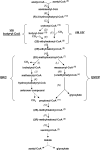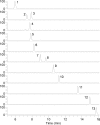Demonstration of the ethylmalonyl-CoA pathway by using 13C metabolomics
- PMID: 19261854
- PMCID: PMC2660752
- DOI: 10.1073/pnas.0810932106
Demonstration of the ethylmalonyl-CoA pathway by using 13C metabolomics
Abstract
The assimilation of one-carbon (C1) compounds, such as methanol, by serine cycle methylotrophs requires the continuous regeneration of glyoxylate. Instead of the glyoxylate cycle, this process is achieved by a not yet established pathway where CoA thioesters are known to play a key role. We applied state-of-the-art metabolomics and (13)C metabolomics strategies to demonstrate how glyoxylate is generated during methylotrophic growth in the isocitrate lyase-negative methylotroph Methylobacterium extorquens AM1. High-resolution mass spectrometry showed the presence of CoA thioesters specific to the recently proposed ethylmalonyl-CoA pathway. The operation of this pathway was demonstrated by short-term (13)C-labeling experiments, which allowed determination of the sequence of reactions from the order of label incorporation into the different CoA derivatives. Analysis of (13)C positional enrichment in glycine by NMR was consistent with the predicted labeling pattern as a result of the operation of the ethylmalonyl-CoA pathway and the unique operation of the latter for glyoxylate generation during growth on methanol. The results also revealed that 2 molecules of glyoxylate were regenerated in this process. This work provides a complete pathway for methanol assimilation in the model methylotroph M. extorquens AM1 and represents an important step toward the determination of the overall topology of its metabolic network. The operation of the ethylmalonyl-CoA pathway in M. extorquens AM1 has major implications for the physiology of these methylotrophs and their role in nature, and it also provides a common ground for C1 and C2 compound assimilation in isocitrate lyase-negative bacteria.
Conflict of interest statement
The authors declare no conflict of interest.
Figures







Similar articles
-
The ethylmalonyl-CoA pathway is used in place of the glyoxylate cycle by Methylobacterium extorquens AM1 during growth on acetate.J Biol Chem. 2012 Jan 2;287(1):757-766. doi: 10.1074/jbc.M111.305219. Epub 2011 Nov 21. J Biol Chem. 2012. PMID: 22105076 Free PMC article.
-
Oxalyl-coenzyme A reduction to glyoxylate is the preferred route of oxalate assimilation in Methylobacterium extorquens AM1.J Bacteriol. 2012 Jun;194(12):3144-55. doi: 10.1128/JB.00288-12. Epub 2012 Apr 6. J Bacteriol. 2012. PMID: 22493020 Free PMC article.
-
Production of 3-hydroxypropionic acid in engineered Methylobacterium extorquens AM1 and its reassimilation through a reductive route.Microb Cell Fact. 2017 Oct 30;16(1):179. doi: 10.1186/s12934-017-0798-2. Microb Cell Fact. 2017. PMID: 29084554 Free PMC article.
-
How half a century of research was required to understand bacterial growth on C1 and C2 compounds; the story of the serine cycle and the ethylmalonyl-CoA pathway.Sci Prog. 2011;94(Pt 2):109-37. doi: 10.3184/003685011X13044430633960. Sci Prog. 2011. PMID: 21805909 Free PMC article. Review.
-
Biotechnological potential of the ethylmalonyl-CoA pathway.Appl Microbiol Biotechnol. 2011 Jan;89(1):17-25. doi: 10.1007/s00253-010-2873-z. Epub 2010 Sep 30. Appl Microbiol Biotechnol. 2011. PMID: 20882276 Review.
Cited by
-
Insight into the surfactin production of Bacillus velezensis B006 through metabolomics analysis.J Ind Microbiol Biotechnol. 2018 Dec;45(12):1033-1044. doi: 10.1007/s10295-018-2076-7. Epub 2018 Sep 10. J Ind Microbiol Biotechnol. 2018. PMID: 30203399
-
Metabolomics in systems microbiology.Curr Opin Biotechnol. 2011 Feb;22(1):17-25. doi: 10.1016/j.copbio.2010.10.001. Epub 2010 Nov 1. Curr Opin Biotechnol. 2011. PMID: 21050741 Free PMC article. Review.
-
Dynamic Metabolic Rewiring Enables Efficient Acetyl Coenzyme A Assimilation in Paracoccus denitrificans.mBio. 2019 Jul 9;10(4):e00805-19. doi: 10.1128/mBio.00805-19. mBio. 2019. PMID: 31289174 Free PMC article.
-
Metabolic footprint of epiphytic bacteria on Arabidopsis thaliana leaves.ISME J. 2016 Mar;10(3):632-43. doi: 10.1038/ismej.2015.141. Epub 2015 Aug 25. ISME J. 2016. PMID: 26305156 Free PMC article.
-
Methylotrophic bacteria with cobalamin-dependent mutases in primary metabolism as potential strains for vitamin B12 production.Antonie Van Leeuwenhoek. 2023 Mar;116(3):207-220. doi: 10.1007/s10482-022-01795-9. Epub 2022 Nov 17. Antonie Van Leeuwenhoek. 2023. PMID: 36385348 Free PMC article.
References
-
- Schrader J, et al. Methanol-based industrial biotechnology: Current status and future perspectives of methylotrophic bacteria. Trends Biotechnol. 2009;27:107–115. - PubMed
-
- Anthony C. The Biochemistry of Methylotrophs. London: Academic; 1982.
-
- Chistoserdova L, Vorholt JA, Thauer RK, Lidstrom ME. C1 transfer enzymes and coenzymes linking methylotrophic bacteria and methanogenic Archaea. Science. 1998;281:99–102. - PubMed
-
- Vorholt JA. Cofactor-dependent pathways of formaldehyde oxidation in methylotrophic bacteria. Arch Microbiol. 2002;178:239–249. - PubMed
Publication types
MeSH terms
Substances
LinkOut - more resources
Full Text Sources
Other Literature Sources
Miscellaneous

